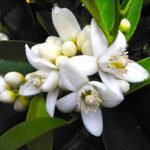
Citrus aurantium
The bitter orange tree gives us three fabulous essential oils, all from one plant:
- Neroli essential oil
- Petitgrain essential oil
- and Bitter Orange essential oil
The bitter orange tree originated in Vietnam, but like all popular plants it is cultivated in many global locations now. It is known to be a very hardy tree, able to resist disease. From marmalade to liqueur to essential oils, its popularity is in no danger of fading.
Neroli
Guess what? The secret ingredient in a very popular soft drink… is Neroli essential oil. Yes, that is right. This unbelievably beautiful oil is one of those strange flavors that you find in Coke. I think that these days the Neroli in it is synthetically produced for economic purposes, but originally it was the true Neroli essential oil.

Orange Blossoms
Neroli essential oil comes from the flowers of the bitter orange tree. This oil is expensive. Why? Because it takes 100 pounds of flowers to distill just one pound of essential oil. These flowers are hand-picked. They are distilled with water due to the fact that steam distillation would be too harsh for this delicate flower. The aroma is sweet and spicy. It was made popular as a perfume in the 17th century by the princess of Nerola, Italy, hence the name. Many perfumes use this oil as an essential ingredient because it is nontoxic, nonirritant, and nonphototoxic.
Mostly you will find this essential oil for sale only if it is diluted with an inexpensive carrier oil like jojoba. That allows you to get the benefits of the aroma of the oil without the steep price tag.
Petitgrain
To make petitgrain essential oil, the leaves and twigs of the bitter orange tree are steam distilled. The countries producing most of Petitgrain essential oils are France and North Africa.
Bitter orange
To make Bitter Orange essential oil, the fruit peel is cold pressed. Egypt, the United States, and Brazil are the largest producers of this fabulous oil. If you don’t like the sweetness of Orange essential oil, try Bitter Orange instead. Blend this essential oil with ginger, lavender, myrrh, or vetiver for an exotic and lovely mix.
Sources: Harding, J. (2010). The Essential Oils Handbook, New York, NY: Sterling Publishing Co., Inc. pp. 130-131, 256-257; Schnaubelt, K., PhD (2011). The Healing Intelligence of Essential Oils. Rochester, VT: Healing Arts Press. pp. 114-115; Haas, M (2004). Quick Reference Guide for 114 Important Essential Oils, San Rafael, CA: Terra Linda Scent and Image. pp. 80, 88.
Articles copyright of Rebecca Mitchell-Guthrie and not to be reprinted without permission.
The information presented on this site is not intended to diagnose health problems or to take the place of professional medical care. The information contained therein is neither intended to dictate what constitutes reasonable, appropriate, or best care for any given health issue, nor is it intended to be used as a substitute for the independent judgment of a physician for any given health issue. All content, including text, graphics, images and information, contained on or available through my web site is for general information purposes only.
Image credit: Orange Tree Branch by Liz West Muffet / CC-BY-2.0
Image credit: photo of Neroli by Starzyia / CC-BY-ND-2.0
